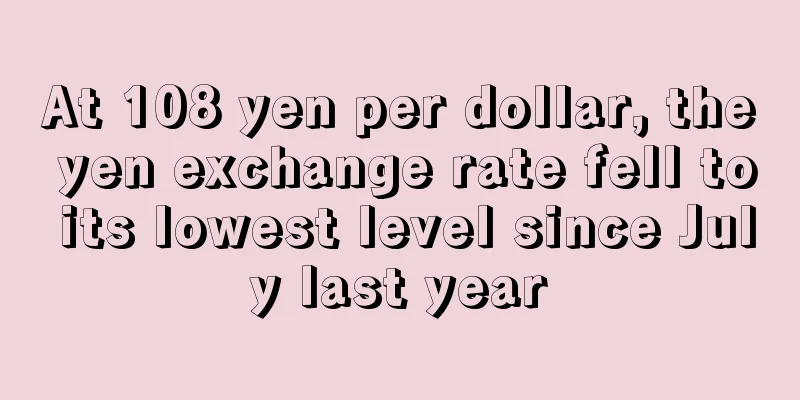At 108 yen per dollar, the yen exchange rate fell to its lowest level since July last year

|
On March 5, in the Tokyo foreign exchange market, affected by factors such as the rise in long-term interest rates in the United States, the US dollar was bought, the yen depreciated and the US dollar appreciated . The highest increase once reached 1 US dollar = 108 yen , which was the lowest level of the yen against the US dollar since July last year .
On March 4, the USD/JPY exchange rate in Tokyo's foreign exchange market opened at around 106.994 yen in early trading, up 0.13 yen from the previous trading day . One day later, the USD/JPY exchange rate in Tokyo's foreign exchange market opened at around 107.948 yen in early trading , up 0.86 yen from the previous trading day.
Against the backdrop of another rise in long-term interest rates in the United States, the USD/JPY exchange rate continued to break upward, once breaking through the 108 yen integer level before closing at a high level.
Previously, all economic data released by the United States were unsatisfactory, especially the ADP private sector job growth , which is a precursor indicator of official employment statistics , was far below market expectations. Coupled with the market's forecast that the Federal Reserve will extend its loose financial policy and the government's expectation that it will introduce larger-scale stimulus policies , long-term interest rates have been further increased.
A person related to the Japanese market said : "Federal Reserve Chairman Powell's speech on the 4th did not show a strong sense of vigilance against rising long-term interest rates in the United States."
However, since interest rates in the Tokyo market are high following those in overseas markets, it is likely that purchases of U.S. dollars are underway or have already occurred, given the decline in long-term interest rates in Japan and the interest rate differential between Japan and the United States.
As the market has been quite sensitive recently, large fluctuations in the USD/JPY exchange rate cannot be ruled out, and we should also be wary of the amplifying effect of stop-loss trading on market materials.
From a technical perspective, the USD/JPY exchange rate continued to rise from the upper limit of the range in late trading, showing a strong upward momentum in the short term. The US long-term interest rate still maintains a medium-term upward trend, which may further widen the US-Japan interest rate gap , so Japanese sellers also need to pay more attention. JPY exchange rate Japanese Market |
<<: eBay launches managed payment service in France, Italy and Spain
Recommend
What is Easy Exchange Settlement
Yijiehui is a brand under Yijifu, which has a thi...
Gender-neutral trend is coming, American women buy more than 3 billion men's clothing!
Many times, we subconsciously believe that women ...
Japan's economy shows signs of weakness, and high-quality and low-priced products are most popular
It is reported that Japanese Prime Minister Yoshi...
What is One Retail Group? One Retail Group Review, Features
One Retail Group is a multinational retailer and ...
Amazon European Small and Light Package Fee Update
Amazon European Small and Light Package Fee Updat...
Swedish second-hand platform Sellpy expands into the Netherlands and Austria
According to foreign media reports, the Swedish s...
The outlook is good! U.S. office supplies sales are expected to grow 8% in 2021
In the post-epidemic era, working from home is st...
What is QuimiNet? QuimiNet Review, Features
Founded in 2000, QuimiNet is a leading business an...
What is Fine Art America? Fine Art America Review, Features
Fine Art America is the world's largest art ma...
Publicly selling free guidebooks? American professional team hurts Chinese sellers
Recently, a post-90s Chinese man was arrested for...
What is Amazon Global Payments? Amazon Global Payments Review, Features
What is Amazon Global Payments? As Amazon's o...
What is Enjoy Cross-border E-commerce? Enjoy Cross-border E-commerce Review, Features
Enjoy Cross-border E-commerce is an e-commerce cr...
XTransfer2024 Future Foreign Trade Conference was held, with Wu Xiaobo and other big names making a grand appearance
On August 15, the "2024 Future Foreign Trade...
What is COSCO SHIPPING LINES Co., Ltd.? COSCO SHIPPING LINES Co., Ltd. Review, Features
COSCO SHIPPING Lines Co., Ltd. (COSCO SHIPPING Lin...
It has taken the No. 1 position in the category in just half a year and has multiple flagship products!
Homan pet Smart pet products...









